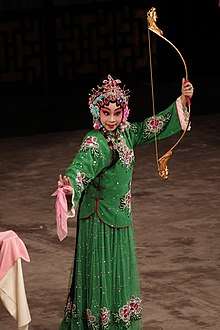Xun Guan
Xun Guan (303–?) was an ancient Chinese female warrior that lived during the Jin dynasty and who famously led a group of soldiers into battle at the age of thirteen. As daughter of the governor of Xiangyang she is said to have broken through enemy lines to assemble reinforcements and prevent the city of Xiangyang from being invaded.[1]
| Xun Guan | |||||||
|---|---|---|---|---|---|---|---|
| Traditional Chinese | 荀灌 | ||||||
| Simplified Chinese | 荀灌 | ||||||
| |||||||
Life and legacy

Xun Guan lived in the Western Jin dynasty (265–316 AD) and was the daughter of Xun Song (荀崧), the governor of Xiangyang, who in turn was descended from Xun Yu, an adviser to Han dynasty warlord Cao Cao. In a revolt, one of the governor's officials Du Zeng surrounded the city with soldiers, attempting to invade and overthrow the governor. While defending the city, provisions declined to a point where more reinforcement were required to stave of the attack. As the city was surrounded the only option was for a party to break through enemy lines and travel to the nearby city of Pingnan to request help. With nobody willing to take the task, the 13 year-old Xun Guan who was skilled in martial arts volunteered for the role much to the hesitation of her father. With a small group of soldier Xun Guan waited to night and penetrated a hole in the enemy encampments to force her way through enemy lines.[2]
After arriving at Pingnan she met with an ally of her father, General Shi Lan who was doubtful to whether his troops were numerous enough to help. He suggested she request additional help from General Zhou Fang, a leader in another city by writing him a letter asking for troops. General Zhou accepted the request and along with General Shi Lan they traveled back to Xiangyang to begin the battle. On their arrival the governor began attacking the enemy's front while Xun Guan and the Generals' soldiers attacked from the rear. Du Zeng's army were overwhelmed and forced to retreating leading to the governor to proclaim victory.[2]
References
- Mayor, Adrienne (2014). The Amazons: Lives and Legends of Warrior Women across the Ancient World. Princeton University Press. p. 420. ISBN 9781400865130.
- "Ten Ancient Chinese Women Warriors". All-China Women's Federation. Retrieved 5 November 2017.